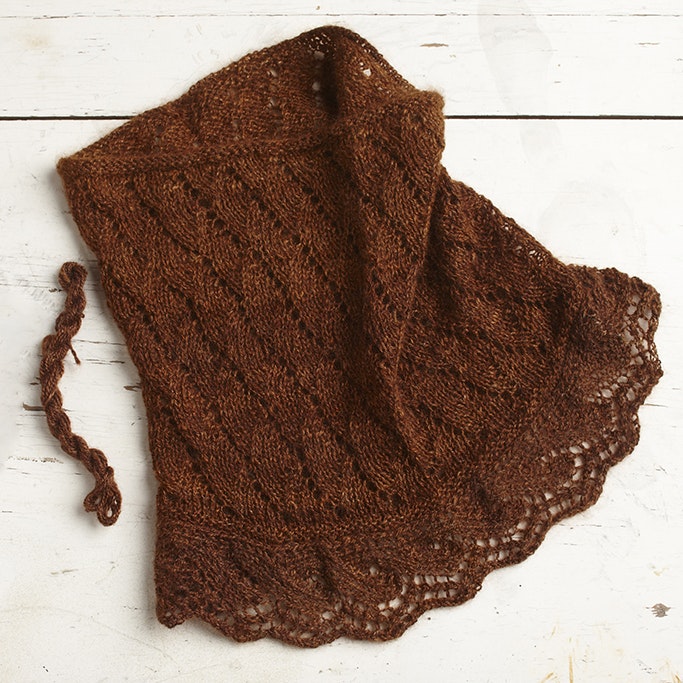Subscriber Exclusive
Knit a Lacy Copper Cowl
Fall into autumn with a project designed to keep out chills yet still breathe, thanks to an open lace stitch pattern.
Fall into autumn with a project designed to keep out chills yet still breathe, thanks to an open lace stitch pattern. <a href="https://farmfiberknits.com/knit-a-lacy-copper-cowl/">Continue reading.</a>
https://farmfiberknits.com/cdn-cgi/image/format=auto/https://www.datocms-assets.com/101500/1696628274-jc-sk42511-0066-header.jpg?auto=format&w=900
The applied lace edging at the base of the Copper Cowl helps it lie flat and gives a lovely finish. Photo by Joe Coca
This cowl combines several of Sara Lamb’s design signatures: rhythmic lace patterns, an applied lace edging, and a rich autumn color. The lace patterns are easily memorized, making this a great project for knitting on the go.
Sara designed this cowl using a pygora yarn. Pygoras are fiber goats, some with soft cashmere-like fiber, some with lustrous mohair-like fiber, and some that split the difference and are both soft and lustrous. Because pygora fiber is unusual, it can be difficult to find commercially available pygora yarn. But another kind of goat fiber, cashmere, serves as a lovely substitution. A cashmere/silk blend offers both softness and luster.

Photo by Joe Coca
MATERIALS AND PATTERN
Finished size 21¾" (55 cm) circumference and 12" (30.5 cm) tall; to fit an adult.
Yarn Laceweight or light fingering 2-ply yarn, about 225 yd (206 m). See Notes.
Needles Size 3 (3.25 mm): 16" (40 cm) circular (cir) needle and one double-pointed (dpn). Adjust needle size if necessary to obtain the correct gauge.
Notions Waste yarn; marker (m); tapestry needle.
Gauge 21 sts and 31 rows = 4" (10 cm) in lace pattern.
See farmfiberknits.com/abbreviations for terms you don’t know.
SUBSCRIBER EXCLUSIVE
Unlock the Full Article with a Farm & Fiber Knits Subscription
Get instant access to this article and the entire Farm & Fiber Knits library of projects, inspiration, and expert instruction. With your subscription, you’ll receive:
Connect more deeply with your yarn—learn the stories of farmers, shepherds, and dyers
Knit patterns that celebrate natural fibers and slow, intentional making
Support a community of small farms, women makers, and independent yarn companies
Includes print and digital issues of Farm & Fiber Knits, delivered directly to you
With must-knit projects and unforgettable stories, Farm & Fiber Knits invites you to see the craft world through fresh eyes.
Plans start at just $5.83/month (paid annually). Cancel anytime.
This cowl combines several of Sara Lamb’s design signatures: rhythmic lace patterns, an applied lace edging, and a rich autumn color. The lace patterns are easily memorized, making this a great project for knitting on the go.
Sara designed this cowl using a pygora yarn. Pygoras are fiber goats, some with soft cashmere-like fiber, some with lustrous mohair-like fiber, and some that split the difference and are both soft and lustrous. Because pygora fiber is unusual, it can be difficult to find commercially available pygora yarn. But another kind of goat fiber, cashmere, serves as a lovely substitution. A cashmere/silk blend offers both softness and luster.

Photo by Joe Coca
MATERIALS AND PATTERN
Finished size 21¾" (55 cm) circumference and 12" (30.5 cm) tall; to fit an adult.
Yarn Laceweight or light fingering 2-ply yarn, about 225 yd (206 m). See Notes.
Needles Size 3 (3.25 mm): 16" (40 cm) circular (cir) needle and one double-pointed (dpn). Adjust needle size if necessary to obtain the correct gauge.
Notions Waste yarn; marker (m); tapestry needle.
Gauge 21 sts and 31 rows = 4" (10 cm) in lace pattern.
See farmfiberknits.com/abbreviations for terms you don’t know. [PAYWALL]
View and print this pattern as a PDF here: Copper Cowl
NOTES
• For a larger or smaller cowl, cast on more or fewer stitches in increments of 6, and repeat the 6-stitch Zigzag chart more or fewer times. Every repeat added or removed will increase or decrease the circumference by about 1¼" (3.2 cm).
• Every 14-row repeat of the Edging chart joins 7 live stitches of the cowl. If you change the number of cast-on stitches, adjust the stitch count after completing the
Zigzag chart so it is a multiple of 7 stitches in order to accommodate the edging.
• The pattern was originally written for handspun yarn. We recommend Lisa Souza Cashmere Silk Fingering as a substitution. You may need to add or subtract pattern repeats to fit.


